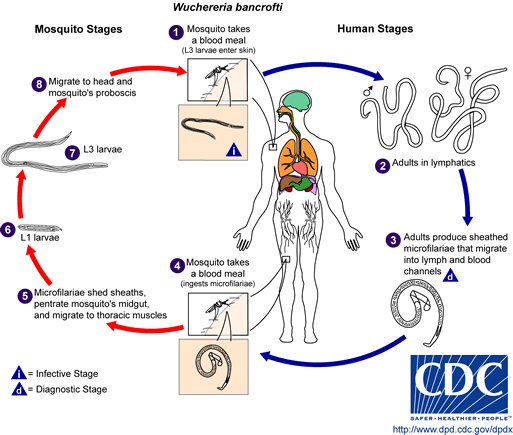Filariasis is caused by nematodes (roundworms) that inhabit the lymphatics and subcutaneous tissues. Eight main species infect humans. Three of these are responsible for most of the morbidity due to filariasis: Wuchereria bancrofti and Brugia malayi cause lymphatic filariasis, and Onchocerca volvulus causes onchocerciasis (river blindness). The other five species are Loa loa, Mansonella perstans, M. streptocerca, M. ozzardi, and Brugia timori. (The last species also causes lymphatic filariasis.)
Infective larvae are transmitted by infected biting arthropods during a blood meal. The larvae migrate to the appropriate site of the host's body, where they develop into microfilariae-producing adults. The adults dwell in various human tissues where they can live for several years. The agents of lymphatic filariasis reside in lymphatic vessels and lymph nodes; Onchocerca volvulus in nodules in subcutaneous tissues; Loa loa in subcutaneous tissues, where it migrates actively; Brugia malayi in lymphatics, as with Wuchereria bancrofti; Mansonella streptocerca in the dermis and subcutaneous tissue; Mansonella ozzardi apparently in the subcutaneous tissues; and M. perstans in body cavities and the surrounding tissues. The female worms produce microfilariae which circulate in the blood, except for those of Onchocerca volvulus and Mansonella streptocerca, which are found in the skin, and O. volvulus which invade the eye. The microfilariae infect biting arthropods (mosquitoes for the agents of lymphatic filariasis; blackflies [Simulium] for Onchocerca volvulus; midges for Mansonella perstans and M. streptocerca; and both midges and blackflies for Mansonella ozzardi; and deerflies [Chrysops] for Loa loa). Inside the arthropod, the microfilariae develop in 1 to 2 weeks into infective filariform (third-stage) larvae. During a subsequent blood meal by the insect, the larvae infect the vertebrate host. They migrate to the appropriate site of the host's body, where they develop into adults, a slow process than can require up to 18 months in the case of Onchocerca.

Different species of the following genera of mosquitoes are vectors of W. bancrofti filariasis depending on geographical distribution. Among them are: Culex (C. annulirostris, C. bitaeniorhynchus, C. quinquefasciatus, and C. pipiens); Anopheles (A. arabinensis, A. bancroftii, A. farauti, A. funestus, A. gambiae, A. koliensis, A. melas, A. merus, A. punctulatus and A. wellcomei); Aedes (A. aegypti, A. aquasalis, A. bellator, A. cooki, A. darlingi, A. kochi, A. polynesiensis, A. pseudoscutellaris, A. rotumae, A. scapularis, and A. vigilax); Mansonia (M. pseudotitillans, M. uniformis); Coquillettidia (C. juxtamansonia). During a blood meal, an infected mosquito introduces third-stage filarial larvae onto the skin of the human host, where they penetrate into the bite wound . They develop in adults that commonly reside in the lymphatics . The female worms measure 80 to 100 mm in length and 0.24 to 0.30 mm in diameter, while the males measure about 40 mm by .1 mm. Adults produce microfilariae measuring 244 to 296 um by 7.5 to 10 um, which are sheathed and have nocturnal periodicity, except the South Pacific microfilariae which have the absence of marked periodicity. The microfilariae migrate into lymph and blood channels moving actively through lymph and blood . A mosquito ingests the microfilariae during a blood meal . After ingestion, the microfilariae lose their sheaths and some of them work their way through the wall of the proventriculus and cardiac portion of the mosquito's midgut and reach the thoracic muscles . There the microfilariae develop into first-stage larvae and subsequently into third-stage infective larvae . The third-stage infective larvae migrate through the hemocoel to the mosquito's prosbocis and can infect another human when the mosquito takes a blood meal.
For more information view the source:Center for Disease Control
Recommended Test:Full GI Panel
Recommended Product:Freedom Cleanse Restore Parasite Cleanse